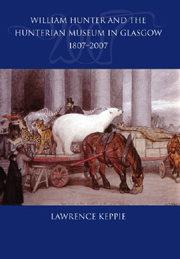Book contents
- Frontmatter
- Contents
- Foreword by Sir Kenneth Calman
- Introduction
- List of Illustrations
- Acknowledgements
- Abbreviations used in the Notes
- Dedication
- 1 William Hunter's Life and Career
- 2 Growth of the Hunterian Collection
- 3 ‘The Noblest Legacy upon Record’
- 4 A Temple of the Muses: the First Hunterian Museum in Glasgow
- 5 ‘This Place of Fascination’: the Impact of the Museum, 1807–70
- 6 A New Museum for a New University, 1870–1900
- 7 The Twentieth Century: War, Peace and Renewal, 1900–75
- 8 The Hunterian Art Gallery
- 9 Modern Times, 1975–2007
- 10 Overview: Meeting William Hunter's Intentions
- Postscript: Looking to the Future
- Notes
- Appendix: Catalogues of the Hunterian Collections
- Bibliography
- Index
- Plate section
6 - A New Museum for a New University, 1870–1900
Published online by Cambridge University Press: 12 September 2012
- Frontmatter
- Contents
- Foreword by Sir Kenneth Calman
- Introduction
- List of Illustrations
- Acknowledgements
- Abbreviations used in the Notes
- Dedication
- 1 William Hunter's Life and Career
- 2 Growth of the Hunterian Collection
- 3 ‘The Noblest Legacy upon Record’
- 4 A Temple of the Muses: the First Hunterian Museum in Glasgow
- 5 ‘This Place of Fascination’: the Impact of the Museum, 1807–70
- 6 A New Museum for a New University, 1870–1900
- 7 The Twentieth Century: War, Peace and Renewal, 1900–75
- 8 The Hunterian Art Gallery
- 9 Modern Times, 1975–2007
- 10 Overview: Meeting William Hunter's Intentions
- Postscript: Looking to the Future
- Notes
- Appendix: Catalogues of the Hunterian Collections
- Bibliography
- Index
- Plate section
Summary
The move to Gilmorehill in i870: demolition and survival
For some decades a move by the University to larger premises had been under considération, in the light of the deterioration of the mass of the seventeenth-century buildings, ever-growing student numbers, the need for improved teaching facilities, and increasing industrialisation of that part of central Glasgow (Figure 6.1). Respectable citizens had already moved westwards to new suburbs.
The localities which they formerly occupied around the College have been filled up by a dense mass of the lowest class of the labouring population, and a large proportion of chemical and other nuisance creating manufactories of the city. The College is in consequence surrounded with an atmosphere impregnated with the effluvia arising from the filth occasioned by such a population, in a town of which the sewerage is far from being in a satisfactory condition.
Pollution had a marked effect on the buildings including the Museum (see p. 78), as well as on trees in the College grounds.
A site at Gilmorehill, on the western outskirts of the city, was finally agreed on, and the existing College buildings sold to a railway company. Extensive new premises, in a neo-Gothic style with Scottish baronial overtones, designed by leading London architect, Sir George Gilbert Scott, rose on a hilltop overlooking a bend in the River Kelvin (Figure 6.2). The Hunterian Museum, a structure very much more modern than almost all of the existing College buildings, was also abandoned to the railway company, and the collections transferred to halls and galleries within the new complex.
- Type
- Chapter
- Information
- Publisher: Edinburgh University PressPrint publication year: 2007



